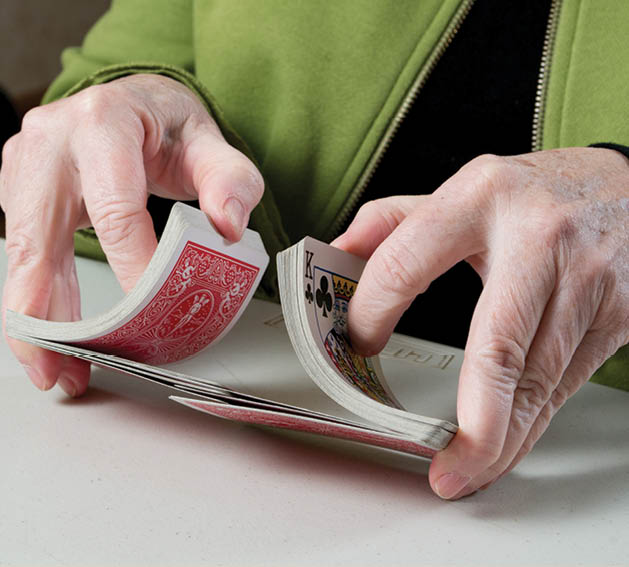Bridge is a dynamic card game that has a bit of an image problem. Poker and blackjack, for example, conjure up visions of high-stakes card games with Vegas lights, dry martinis and Lady Luck. Even children’s games like crazy eights and slap jack have a reputation for being entertaining.
When most people think of bridge, however, they imagine a quiet foursome politely playing cards over tea and finger sandwiches.
Woodbury Bridge Club is out to set the record straight. The club’s gatherings are held in a crowded room full of bridge players who are carefully strategizing, plotting and placing bids. They’re loud. They’re passionate. And they’re too focused on their game to bother with tea and sandwiches.
The Woodbury Bridge Club began in 2005 after a conversation that took place in an unlikely spot—the Woodbury YMCA swimming pool. A few fellow swimmers expressed their interest in learning bridge to Frances Langevin, a former bridge instructor, St. Paul College teacher, and local resident. Langevin organized bridge lessons for those four swimmers, more people joined in over time, and today, the club boasts more than 80 members.
“We loved Fran,” says club president Carol Seifert of Langevin, who led the club until she passed away in 2011. “She gave us a great understanding of the game.” Langevin worked closely with club members, making sure they reached certain skill benchmarks before moving up in the game and ultimately graduating from social bridge into competitive games. “It was quite an honor when Fran asked me to take over as president; I still hear her voice in my ear,” says Tom Boylan, former president and current board member.

Club president Carol Seifert
From the beginning, the club’s mission has been simple. “Teach the game of bridge, create a nice environment to play together and develop friendships, and hold meetings for people who want to learn the game,” Seifert says. They also give back to the community through an annual donation to the Woodbury food shelf.
A typical club meeting begins at 9 a.m. in one of the rooms at Central Park. Before long, the room is filled to capacity and games are underway. While game play continues until noon, lessons are offered at 11:30 a.m. The club is not currently sanctioned, but “anyone can join the American Contract Bridge League (ACBL) if they’re interested,” Boylan says.
The club has fostered so many friendships that members occasionally meet at dinner parties or games held in club members’ homes. Additionally, 38 of the members play marathon bridge outside of the official club meetings. “For marathon bridge, we meet in homes from September through May to play 20 hands. Then, after keeping track of the scores, we have a party in the spring to reward the first-through third-place winners,” says club board member Joyce Velte Hennessy.

All are Welcome
The Woodbury Bridge Club includes members ages 55 and up. While they come from varying backgrounds and professions—the most senior member is a WWII veteran in his 90s—they all share a love for cards, a desire to learn and improve their game, and an interest in developing friendships. “Bridge seems to be easier for those who have played cards for most of their lives, or who have a certain amount of card knowledge,” says club secretary Laura Davenport.
The members agree that it is never too late to learn bridge. “A lot of people played in college and then quit when they went on to work and raise families,” Boylan says. “Others, like me, didn’t learn how to play until after retirement.”
Velte Hennessy remembers her early bridge years fondly, saying, “I learned how to play at St. Theresa’s in Winona, where we sat in a smoker to play. I didn’t pick it up again for 30 years.”

Joyce Velte Hennesy
Member Georgann Maendler says, “I played right after I was married. There was a neighborhood group that got together, so a friend and I decided to learn how to play. Later on, I had to quit when I went to work and couldn’t stay up as late as the bridge group.”
The intellectual and social aspects of the club are the two biggest draws for members. “The ability to meet other people in the community has been a plus for me. Plus, the game is always challenging, which makes it interesting,” Velte Hennessy says.
“Every Friday morning, for the past seven years, I have played with the same foursome,” Seifert says. “This game keeps your mind active. You’re constantly learning new things.”
“You’re always welcome here,” says member Gloria Dombrock. “It’s like the T.V. show Cheers—everyone knows your name and you’ll be greeted with a smile.”
The Younger Generation
One concern among bridge players is the game’s gradual decline in popularity since the 1960s, and how to attract students and adults under age 50 to the game. “We keep looking for opportunities to pass the game on to younger generations,” Seifert says. The club’s board has discovered that some Minnesota high schools host student bridge clubs, and is interested in partnering with School District 833 to initiate similar programs in the local community.
The Woodbury club members aren’t alone in that pursuit. In a 2008 broadcast interview with CBS News Sunday, businessmen Bill Gates and Warren Buffett discussed their mutual passion for bridge and their commitment to introduce the game to younger players. Buffett, who plays bridge 12 hours each week, says, “The main thing is to get [young people] playing and have them play long enough that it grabs them.”
Buffett and Gates play regularly in ACBL tournaments and have helped fund in-school bridge programs in the past. “[Bridge is] deliciously simple in the rules, but deliciously complex in doing it well,” says Gates in the CBS News Sunday interview. “This is actually one of the last games where the computer is not better.”
Looking ahead to the future, Dombrock says, “In addition to recruiting younger players to learn the game, we’d love to see a senior center built in Woodbury that has a larger space we can use. That would help us grow this program and accommodate more people in our community.”
Until then, the club will continue to debunk bridge’s quiet reputation through lively, and at times cutthroat, games played in a crowded room in Woodbury’s otherwise serene Central Park.
Where to Play
Anyone who enjoys card games is welcome to join the Woodbury Bridge Club. “We’re open to any new member who can join with a partner to play,” says club member Laura Davenport. “We play social bridge on Mondays. And on Thursdays, we play duplicate bridge, which is a competitive game where everyone plays the same hand, but we switch tables. The team that plays the best hand with the same cards is the winner.” Members and nonmembers can also play online via Bridge Base Online (bridgebase.com), which is affiliated through the American Contract Bridge League. “You can reserve an online table with friends, but it’s also fun to play with people from all over the world,” Davenport says.
For more information on the local club, go to woodburybridgeclub.com or call Woodbury Parks and Recreation, 651.714.3585.

How To Play
- Object: The game of bridge has two main parts: the bidding (also called the auction) and the play. The object of the game is to win tricks for your side. A trick consists of four cards, one from each player in turn, clockwise around the table. Hence, there are 13 tricks to be won on each deal.
- Number of players: Four people who play in pairs, with partners facing each other at a game table, play bridge. Tradition refers to the pairs as north-south and east-west.
- The cards: Each deal requires a regular 52-card deck. In bridge there are four suits and they are ranked: spades (highest), hearts, diamonds and clubs (lowest). The ranking is for bidding purposes only. In the play all suits are equal, unless one suit has been named as trumps, in which case it beats the others.
- To play: After all of the cards have been dealt, the dealer begins the bidding. The purpose of bidding is just to determine which player will be the declarer (the partner who declares the final bid) and how many tricks the partnership must win with their chosen suit as trumps (the card in the trump suit whose trick-taking power is greater than any plain suit card.) The play of the hand begins once the bidding is over and it comprises 13 tricks in all.









